
<< Back | Home | Site Map
In August 1964, Mr. K. A. Stewart, a former Foreman at the Mildura locomotive depot, wrote to Mildura City Council advising of the availability of a D3 Class engine for preservation for historical purposes. It was planned to scrap the locomotives if they were not wanted. Mr. Stewart highlighted the role of D3 Class locomotives in train services on the Mildura line. Council discussed the idea at their meeting on 27-8-1964 and decided to investigate the possibility and the cost involved. It appears that no further action was taken at the time.
In March 1967, the Director of the Mildura Arts Centre (Mr. T.G. McCullough) suggested to Mildura City Council that Rio Vista Park, opposite the Arts Centre, should have a representative of the steam locomotive era with the display of early local machinery. Council decided to seek the cost of getting a locomotive but there was some doubt whether Rio Vista Park had enough room. A proposal to locate the engine on the turntable at the locomotive shed near Mansell Reserve was put forward. Nothing came of any if these proposals.
Mildura City Council wrote to the Victorian Railways in November 1971 to ascertain if a suitable locomotive could be made available for preservation in Mildura and the cost of purchase. The council was interested in siting the engine in a children's playground in a park it hoped to establish at the ash pit area of the old power house near the riverfront. In late November the railways indicated that there were no steam locomotives available, the few in existence being kept on standby.
Mildura City Council received advice on 25-7-1972 that the Victorian Railways had a D3 Class locomotive available at the Ballarat North Workshop for $600 and another $440 to cover transport. It was decided to purchase the locomotive but to try and negotiate a lower transport cost. In October 1972, the Mildura City Council Engineer, Mr. A. Thomson, asked Mildura Jaycees to consider donating $1,040 to purchase the Ballarat locomotive. The Jaycees had already agreed to assist the council to develop the proposed playground by providing $5,000 over five years and agreed to fund the purchase.
The Steam Preservation and Co-ordinating Committee, representing the main railway enthusiast and preservation groups in Victoria, wrote to Mildura City Council in March 1973, asking council not to take delivery of the D3 Class engine. The Committee explained that the D3 engine was required for replacement parts for the only other D3 engine being operated as a tourist excursion locomotive. The Committee suggested a J or K Class locomotive would be a suitable replacement as both classes were in service at Mildura. Council agreed to the request and locomotive K175 was made the subject of the purchase.
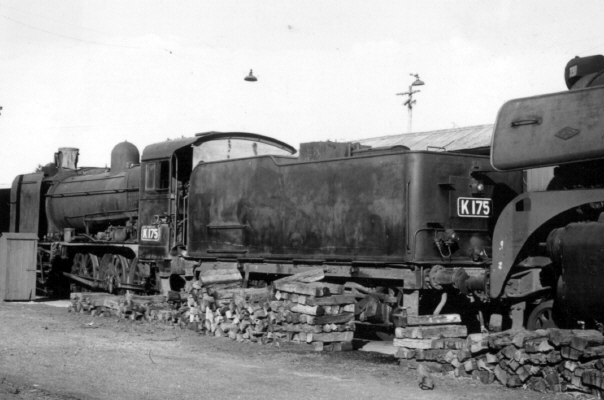
K175 in temporary storage at Bendigo in 1966. Photo: Rev. Leon Marshall-Wood
K175 was removed from the Rolling Stock Register on 23-5-1973 and was towed from Ballarat North Workshops to Ballarat station yard on 8-6-1973 by pilot engine Y169. Chalked on the side of the tender was a notice proclaiming "To be Preserved at Mildura".
K175 arrived in Mildura on 12-6-1973, being hauled by a goods train from Ballarat. The service history of K175 since it first went into temporary storage appears at the end of this segment.
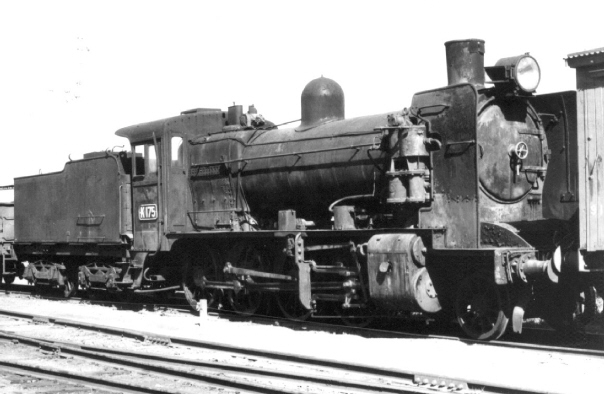
K175 on the morning of its arrival on 12-6-1973 for preservation in a new playground to be established near the Murray River frontage. The locomotive was stabled on the diesel locomotive fuel point road until preparations were completed for its transfer to its new home. Photo: Bruce McLean
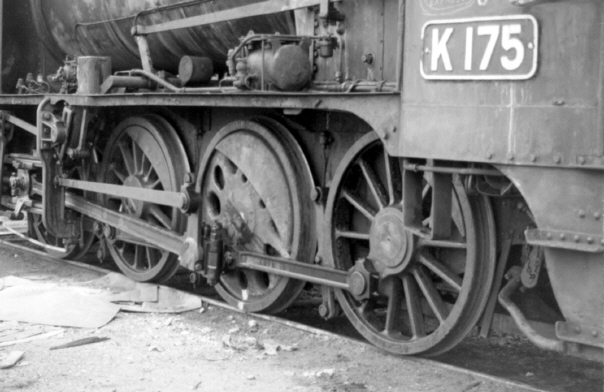
K175 was fitted with a set of Boxpok type wheels. Mildura 12-6-1973. Photo: Bruce McLean
The new cattle yards were opened on 5-9-1973 and the first load of cattle were despatched on 7-9-1973. The tracks serving the old riverfront site were then dismantled in panels still with sleepers attached, to form a temporary track from the bottom of the incline from the station yard to enable the transfer of steam locomotive K175 to its preservation site below the railway yards on the site of the old power station ash pit.
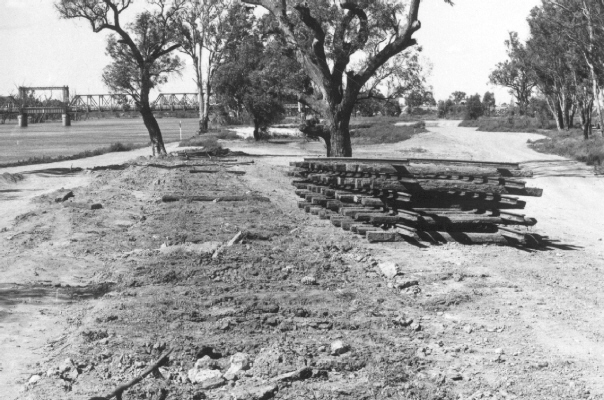
The Mildura City Council dismantled the old Mildura wharf line in sections to enable sections of track to be used for transferring K175 from the bottom of the downgrade to the preservation site past the old Mildura powerhouse. 13-9-1973. Photo: Bruce McLean
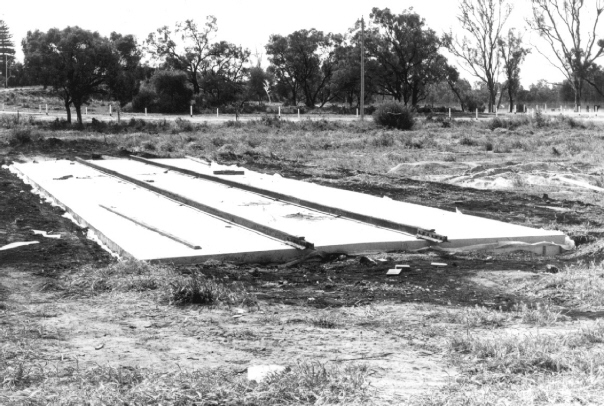
Mildura City Council workmen built a concrete pad with rails attached to house K175. Note the fishplates in position to connect with the temporary track used to transfer the locomotive. 14-9-1973. Photo: Bruce McLean
K175 was moved in four stages using three rail panels and a council bulldozer for haulage power - the first stage on 11-9-1973 to the bottom of the downgrade line from the station yard (pushed by a diesel locomotive). The second move was to a point below the railway goods sheds on 14-9-1973. The third movement was made on 17-9-1973 to a point near the concrete standing pad. Here K175 was steam cleaned during the first week of May by local contractor R. Hellwege. The final move was made on 28-4-1974 when K175 was pulled to its final resting place by the Australian Regular Army's signal squadron's heavy-duty field service crane-tow truck.
The following series of photographs illustrate K175's final journey.
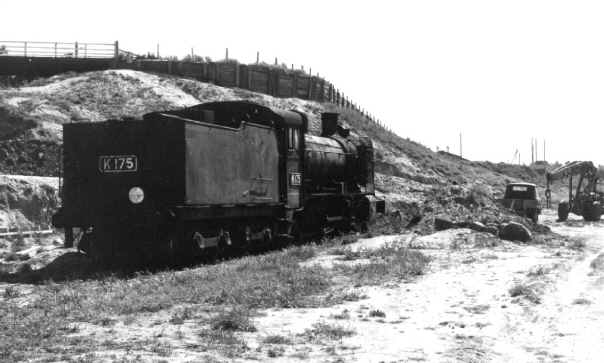
K175 was pushed to the bottom of the downgrade line by a diesel locomotive on 19-11-1973. Photo: Bruce McLean
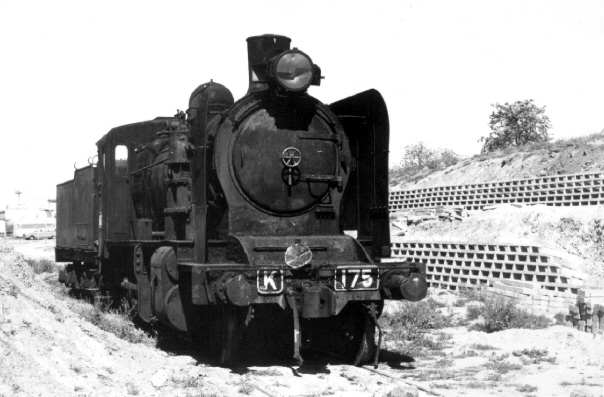
The crib wall against the railway embankment in the background indicates that the riverfront beautification was well advanced when K175 was moved. K175 is standing at the bottom of the downgrade. 11-9-1973. Photo: Bruce McLean
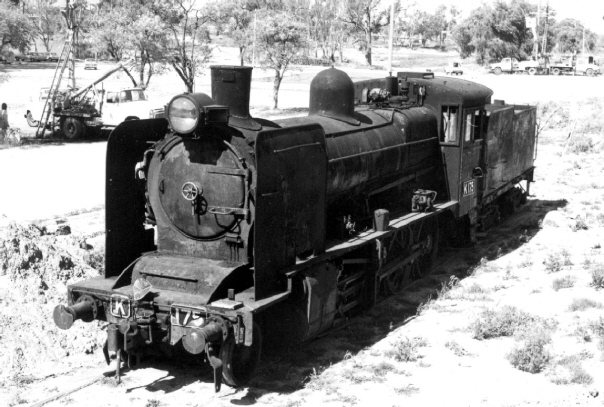
K175 at the bottom of the downgrade line. In the background were the points leading to the wharf siding and cattle yards. 11-9-1973. Photo: Bruce McLean
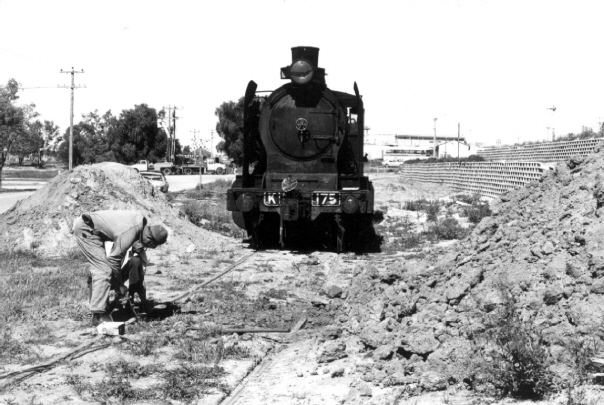
Mildura City Council workmen are preparing to sever the track at this point in order to be able to line up panels of track removed from the wharf line to take K175 in the direction of its final destination. 11-9-1973. Photo: Bruce McLean
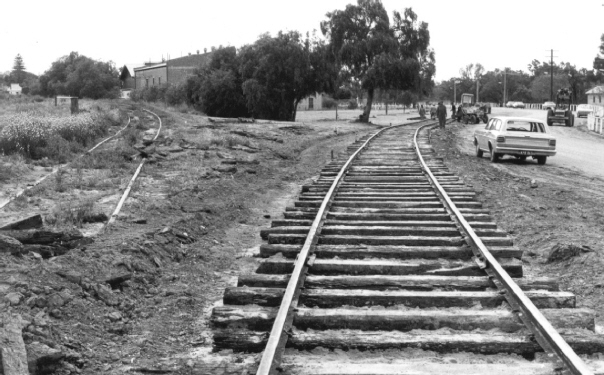
Track panels from the wharf line have been set out in the direction of the new playground on the site of the former siding that served Mildura power house. The downgrade line can be seen to the left. A carriage-way of Hugh King Drive now occupies this site. 14-9-1973. Photo: Bruce McLean
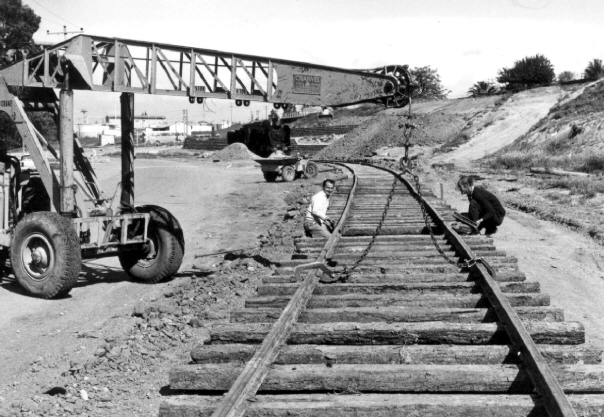
Workmen laying the track panels to enable K175 to be moved easily towards its playground destination. The operation was undertaken by pulling the locomotive forward to the end of the panels, removing panels from behind the locomotive to the front and repeating the process.14-9-1973. Photo: Bruce McLean
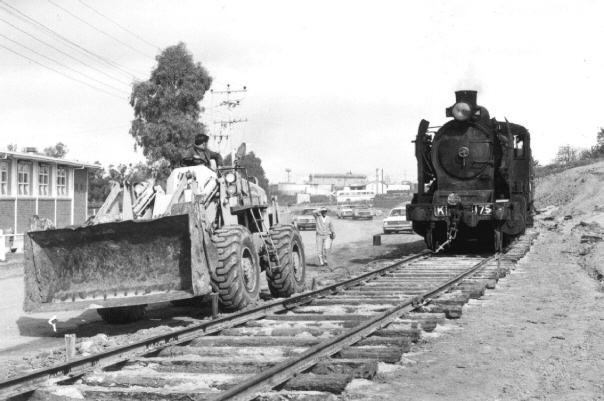
A Mildura City Council front-end loader was used to pull K175 along the temporary track. The whisp of smoke from the funnel was generated by a hessian bag soaked in fuel and ignited by a council worker to create a more realistic effect as the locomotive moved along the track. 14-9-1973. Photo: Bruce McLean
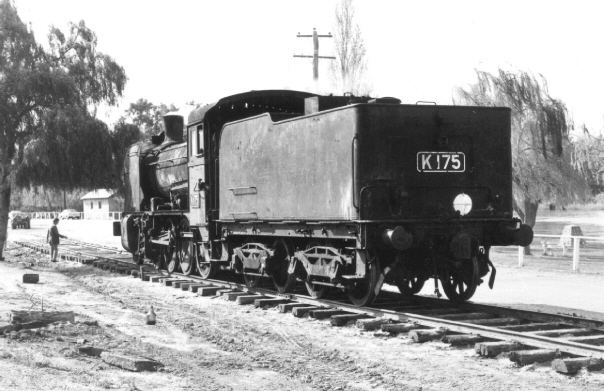
With the Murray River in the background, K175 is pulled cautiously along the temporary track. 14-9-1973. Photo: Bruce McLean
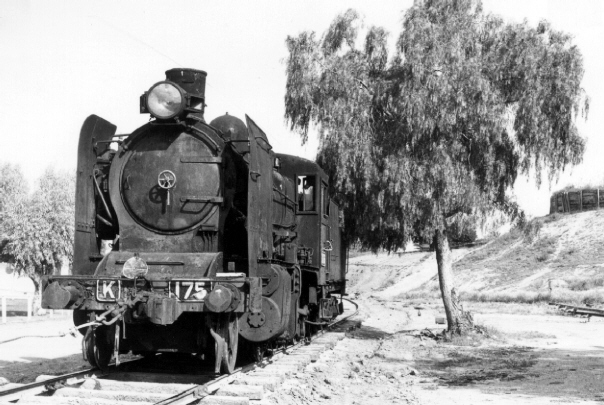
K175 is eased passed a peppercorn tree as it nears the end of the track panels. 14-9-1973. Photo: Bruce McLean
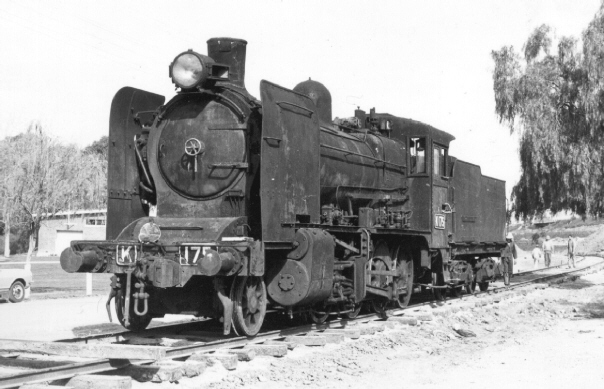
K175 was left at this point over the weekend. Work resumed on 17-9-1973. Photo: Bruce McLean
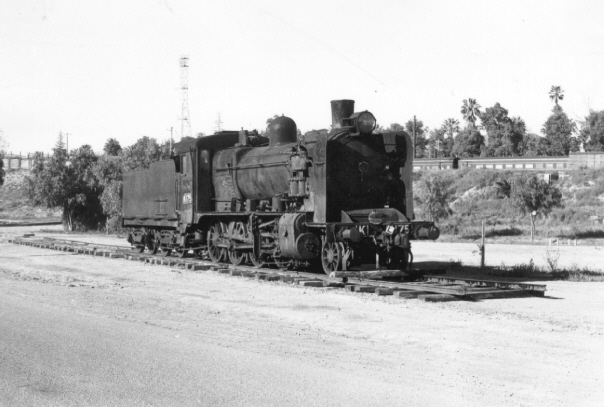
K175 was left standing isolated on this section of temporary track over the weekend of 15/16-9-1973. Photo: Bruce McLean
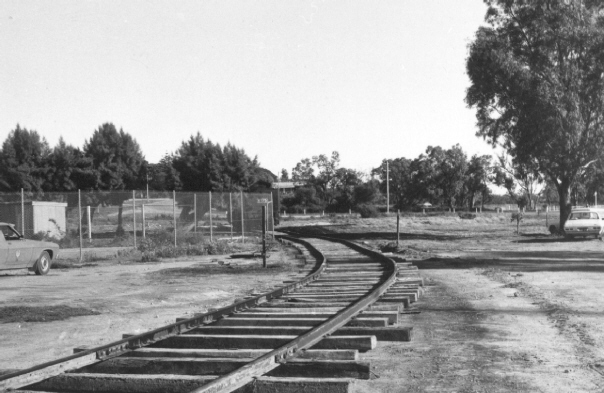
On 17-9-1973 the final lengths of track were laid and connected to the rails on the concrete pad. Photo: Bruce McLean
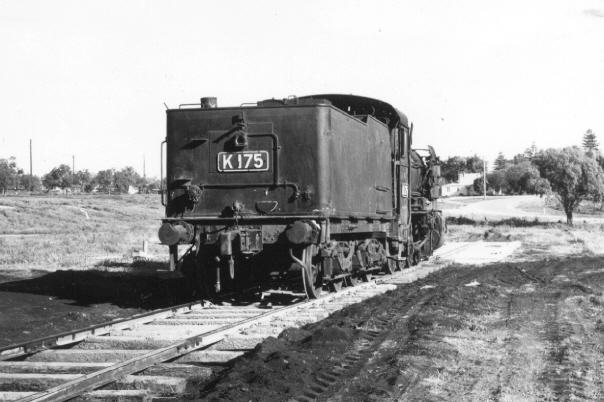
K175 has reached the concrete pad. Before it was moved onto the pad for permanent preservation the Mildura Jaycees arranged to have the locomotive steam cleaned. 17-9-1973. Photo: Bruce McLean
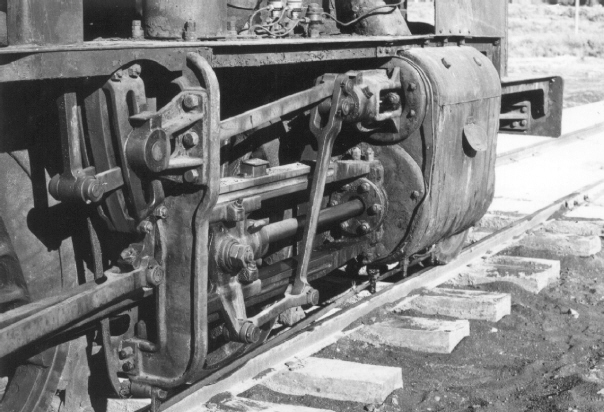
The right hand valve gear of K175. The last movements of the valve gear were made on 28-4-1974 when K175 was moved to the concrete pad constructed to provide its final resting place. 17-9-1973. Photo: Bruce McLean
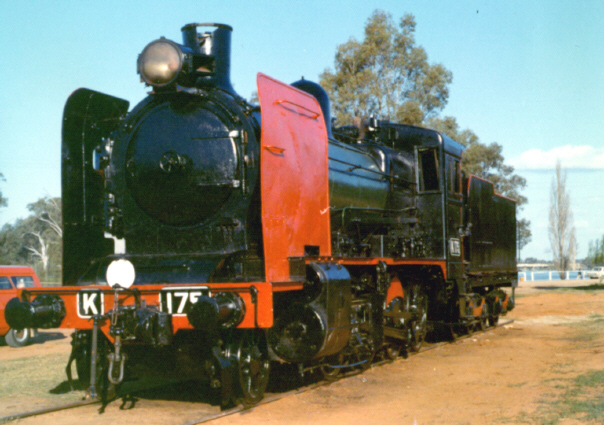
K175 has been repainted by the Mildura Jaycee members with some liberal use of red paint. 17-8-1974. Photo: Bruce McLean
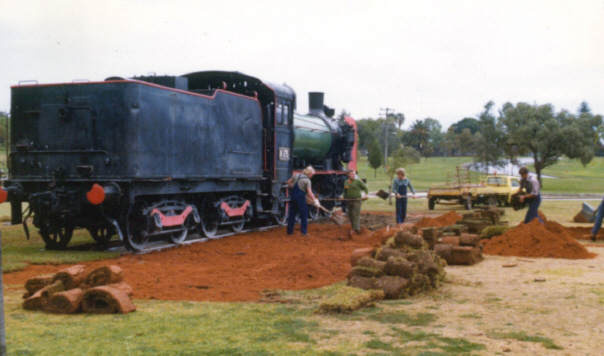
Following a fall and subsequent injury sustained by a child from the top of the locomotive, concrete surrounding the locomotive was replaced by grass. 28-5-1980. Photo: Bruce McLean
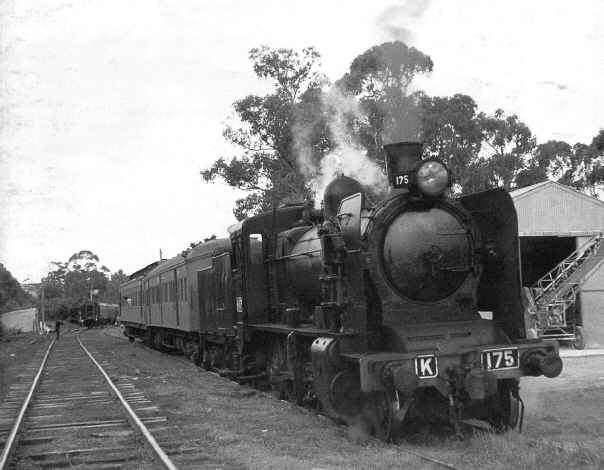
K175 when it was based at Geelong with an Australian Railway Historical Society special train at Timboon. Photo: E.Hogan, Bruce McLean Collection
The Mornington Railway Preservation Society approached Mildura City Council in May 1985 to seek components off K175 for the restoration of K163 and D3 688. Council referred the request to Mildura Jaycees. The parts being sought included grates and screens inside the firebox, compressor governor and lubricators, turbo generator, whistle and A6 brake valves.
A 12 year old visitor from Hawthorn, Melbourne, wrote to the President of the Mildura Jaycees in May 1986 requesting that the locomotive be "spruced up". After two months preparation, an amount of $600, some welding done by Mildura City Council and the Department of Corrective Services volunteering to paint it, K175 was looking smart again by August 1986.
Mildura City Council decided in November 1989 that the asbestos cladding on the locomotive had to be protected from exposure and engaged contractors to apply a fibreglass covering over the boiler barrel.
A fence was erected around the locomotive in June 1991 and signs placed advising that climbing on the locomotive was prohibited.
Date |
Status |
3-12-1962 |
Returned to service after being stored at Geelong |
10-8-1964 |
Transferred from Geelong to Bendigo |
17-10-1964 |
Temporary storage at Bendigo |
8-12-1964 |
Returned to service. During this time, K175 was regularly working at Ouyen. |
22-10-1965 |
Temporary storage at Bendigo |
16-12-1965 |
Returned to service During this time, K175 was regularly working at Ouyen. |
3-2-1966 |
Temporary storage at Bendigo |
23-2-1968 |
Returned to service after AB examination |
Pilot duties at Geelong | |
24-7-1968 |
Temporary storage at Geelong |
20-12-1968 |
Returned to service |
25-7-1969 |
Temporary storage at Geelong |
1-10-1969 |
Returned to service |
15-6-1970 |
AB examination |
21-8-1970 |
Temporary storage at Geelong |
Ballarat North Workshops shunter | |
26-2-1973 |
Failed main internal steam pipe |
23-5-1973 |
Removed from Rolling Stock Register |
8-6-1973 |
Towed from Ballarat North Workshops to Ballarat yard |
11-6-1973 |
Towed Ballarat to Mildura |
12-6-1973 |
Arrived Mildura |
14-9-1973 |
Moved from Mildura station yard to bottom of downgrade line to riverfront. Towed by tractor on temporary track to about half way to destination. |
17-9-1973 |
Towed by tractor to preservation site |
28-4-1973 |
Moved to final position on concrete pad for preservation. |
| << Back | Home | Site Map | Copyright © 2003 Bruce McLean, All Rights Reserved |